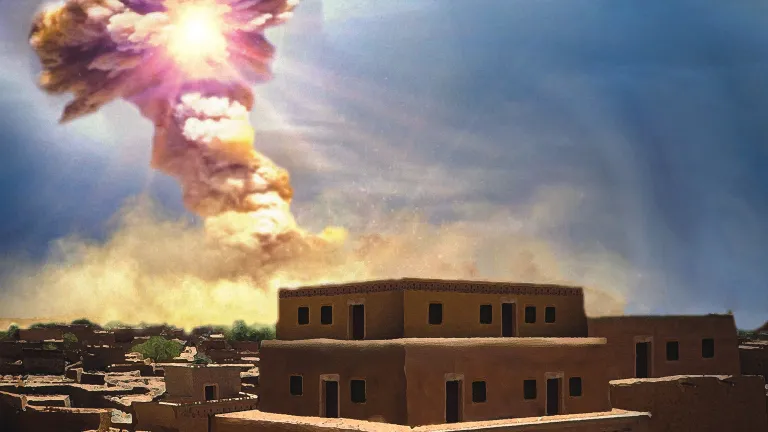God, Science and the Bible: Scientists create petrified wood in a week
A team of materials scientists at a U.S. Department of Energy laboratory in south-central Washington state has discovered a way to do in days what supposedly takes nature millions of years to achieve—convert wood to mineral, forming petrified wood (EurekAlert, Jan. 24).
A team of materials scientists at a U.S. Department of Energy laboratory in south-central Washington state has discovered a way to do in days what supposedly takes nature millions of years to achieve—convert wood to mineral, forming petrified wood (EurekAlert, Jan. 24).
Petrifaction, as The Harper Encyclopedia of Science explains, is "an aspect of the mineralizing process called replacement; it is commonly associated with wood that has been replaced molecule for molecule by silica (generally opal or chalcedony).
"The petrified forests of our Western states are splendid examples. Forests were buried by ash fall from volcanic eruptions, and burial [without oxygen] prevented total decay of the wood. Later, ground water circulated through the ash, picked up silica from it, and carried it to and into the logs. There slowly the silica was deposited, replacing the wood bit by bit . . .
"The replacement is so minute that as a rule the cell structure of the wood is preserved, and even the growth rings, bark, and similar features can easily be recognized" (Vol. 3, p. 900).
This is commonly understood to involve a span of eons. "For instance, at the Ginkgo Petrified Forest, a state park on the west shore of the Columbia River in central Washington, trees were believed to have been buried without oxygen beneath molten lava millions of years ago" (Associated Press, Jan. 25).
Yet Yongsoon Shin and colleagues at the Pacific Northwest National Laboratory in Richland, Washington, have now duplicated the process in less than a week. How?
"They gave a 1 centimeter cube of wood a two-day acid bath, soaked it in a silica solution for two more . . . air-dried it, popped it into an argon-filled furnace gradually cranked up to 1,400 degrees centigrade to cook for two hours, then let cool in argon to room temperature.
"Presto. Instant petrified wood, the silica taking up permanent residence with the carbon left in the cellulose to form a new silicon carbide, or SiC, ceramic. The material 'replicates exactly the wood architecture,' according to Shin" (EurekAlert).
Why is it assumed that this process must have taken ages in nature? Because it fits with evolutionary presuppositions about geologic ages marked out by slow deposits of sediment throughout a uniformitarian past in which there have been almost no cataclysmic changes over vast spans of time.
The truth is that it need not be so. As Creation magazine points out: "There is ample evidence that petrifaction need not take very long. Hot water rich in dissolved minerals like silica, as found in some springs at Yellowstone, has petrified a block of wood in only a year" (March-May 1999, p. 20, citing A.C. Sigleo, "Organic Chemistry of Solidified Wood," Geochimica et Cosmochimica Acta, 1978, Vol. 42, pp. 1397-1405).
And now we see that it can be done in a lab in a much shorter time than that.
Indeed, considering all the natural factors that have happened over even just thousands of years—volcanoes, weathering, erosion, changes in pressure and temperature, and, if you believe the Bible, the great Flood around 4,300 years ago and the tectonic upheaval that must have accompanied it—is it really so remarkable that petrified wood could have formed naturally in a much shorter span than millions of years?
Of course, petrifaction of wood may have taken long eons in some cases. We often can't know. While many creationists argue that the Bible shows the earth to be only 6,000 years old, that is not what Scripture actually states.
Most of Genesis 1 describes a period of renewing and restoring the earth's surface, which had been destroyed in an earlier calamity between verses 1 and 2. The restoration and creation of man did take place around 6,000 years ago. But the earth itself could easily be considerably older (for more information, request our free booklet Creation or Evolution: Does It Really Matter What You Believe?).
Be that as it may, we would be wise to not accept as dogma what the scientific community claims to know concerning millions or hundreds of millions of years for various things to have transpired on the earth—as the recent laboratory experiments help to show.
We should be especially wary when "scientific" opinion appears to contradict Scripture. While it may be that the interpretation of the Bible is the problem, it could also be that the scientists do not understand as much as they think.






